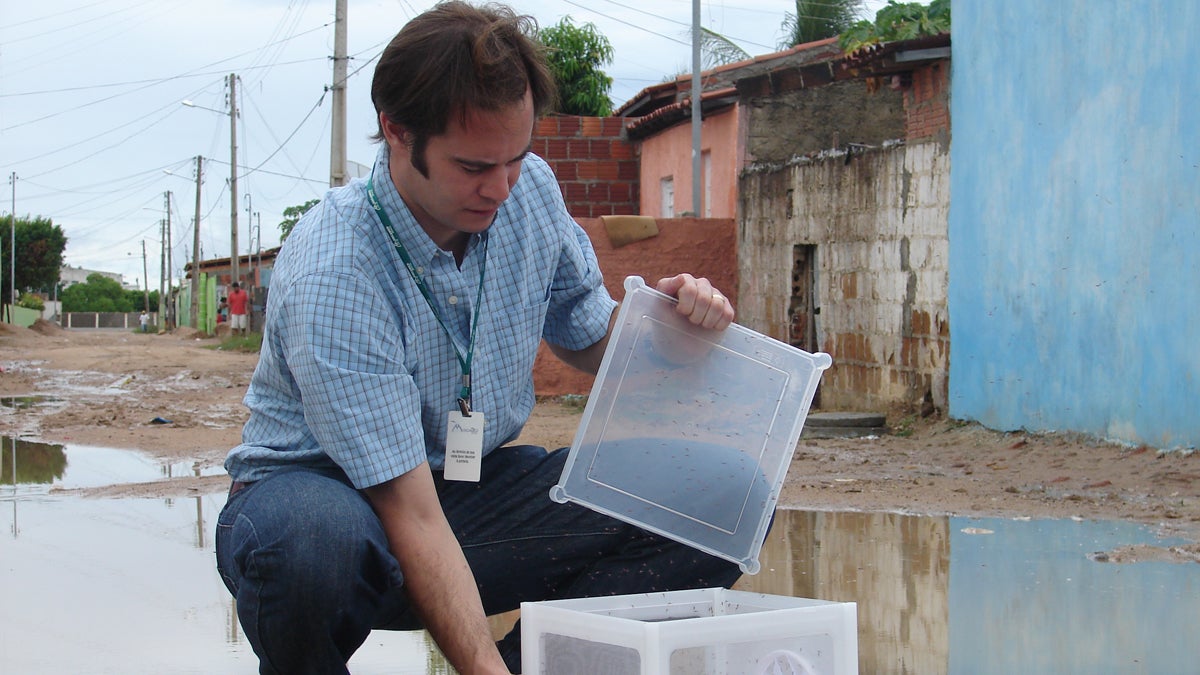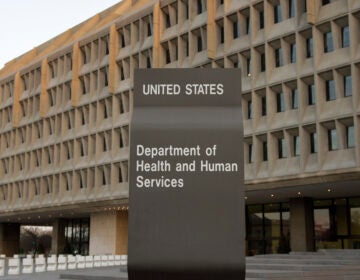N.J. faces growing health threat from virus-carrying mosquitoes
Rising temperatures and longer mosquito season create a ‘perfect storm’ for virus transmission.

Dr Andrew McKemey releasing Oxitec male mosquitos. (Courtesy of Oxitec)
This story originally appeared on NJ Spotlight
—
New Jersey officials are bracing for the start of this year’s mosquito season amid growing signs that a warming climate is creating more favorable conditions for the survival of species that carry Zika and other dangerous viruses.
Rising temperatures are making it more likely that New Jersey will become a regular breeding ground for Aedes aegypti, a species that carries Zika, dengue, yellow fever and Chikungunya, but which has been seen only sporadically in the state so far.
New Jersey winters historically have been cold enough to kill the eggs of that species, preventing it from establishing a population, but Aedes aegypti, also known as the yellow fever mosquito, is spreading northwards from its base in the U.S. Southeast, and officials now say it is likely to become more common in New Jersey in coming years as summers warm and winter temperatures moderate.
“What it’s telling me is that our climate is in fact warming and we are seeing mosquito species that normally wouldn’t be able to survive doing quite well,” said Scott Crans, who heads New Jersey’s mosquito-control program at the Department of Environmental Protection. In the case of Aedes aegypti, “I think it’s just a matter of time before it remains warm enough during the winter months for the eggs to survive,” he said.
According to the State Climatologist, Dr. David Robinson, January was the 35th-mildest for the month since 1895.
Climate-related health threat
Mosquito-borne viruses, also known as arboviruses, are among climate-related health threats that were named by the Infectious Disease Society of America when it announced in early February that it is joining the Medical Society Consortium on Climate & Health, a nationwide group of physicians that educates doctors and patients about the health effects of climate change.
Among the challenges, the consortium said, was that the spread of Aedes aegypti from the southeastern U.S. to the mid-Atlantic states and the Midwest is being aided by people who unwittingly carry mosquito eggs from affected areas when they travel.
It also identified health threats from water-borne infectious diseases that can be caused by sea-level rise and increased flooding, displacement of populations, and the disruption of wildlife, bringing them into contact with different species and ecosystems.
The number of cases of disease spread by mosquitoes, ticks and fleas tripled to about 96,000 between 2004 and 2016, the consortium said, citing data from the federal Centers for Disease Control and Prevention.
The CDC says mosquitoes are the main way that Zika spreads to humans but that it can also be transmitted through sexual activity. The virus is linked to birth defects but most people who become infected won’t experience symptoms such as fever, rash and joint pain, the CDC says. It confirmed four cases of Zika, for which there is no vaccine, in New Jersey in 2018.
‘Disease danger days’
Throughout the country, there are now more so-called disease danger days between March and November when the temperature ranges between 61 and 93 degrees Fahrenheit, creating an increased risk of contracting a disease carried by mosquitoes, according to an analysis by Princeton-based Climate Central, a research group.
In New Jersey, Newark saw seven more “disease danger days” in 2017 than in 1970, while Atlantic City saw an increase of 18 days, Climate Central said in a report last year.
The warming trend is likely to create the right conditions for Aedes aegypti to establish itself in New Jersey, argued Randy Gaugler, an entomologist at Rutgers University’s Center for Vector Biology. He said he hasn’t so far seen new evidence that the species is spreading in the state but thinks it will do so in response to climate change.
He cited CDC forecasts that the species is “likely” to establish itself in the southern two-thirds of New Jersey, and that the southwestern part of the state, as its warmest area, is “very likely” to be suitable for the species to survive and reproduce.
“Climate change will be a game changer — widely predicted to extend the geographical range of many mosquito species farther north,” Gaugler wrote in an email. “I find it hard to disagree with the CDC’s models.”
Asian tiger mosquito is already here
Even if Aedes aegypti doesn’t establish itself in New Jersey as soon as experts expect, Zika can also be spread by another mosquito, Aedes albopictus, also known as the Asian tiger mosquito, which is already well established in New Jersey, and thrives in the warm, wet conditions brought by climate change.
Like other species, Aedes albopictus is moving north as temperatures rise. The first sighting in New Jersey was in Monmouth County in 1995, and it has now spread to Sussex County and further north into New York and Connecticut, said Crans of the DEP.
As for Aedes aegypti, the last confirmed instance was in Union County in June 2016 when a single female was captured in a light trap, one of some 250 devices that officials use throughout the state to monitor and capture mosquitoes in places where they are expected to be most active.
“My first response was: ‘You’re making this up,’” Crans said when he heard from an entomologist on site that the mosquito had been identified as Aedes aegypti. “It shouldn’t be here.” It had not been seen in the state since 1991.
State and county officials looked but failed to find any others and then treated intensively for mosquitoes in the area, Crans said.
Mosquito ‘season’ starts earlier, ends later
That species has not been reported in New Jersey since the Union County case but Crans thinks it won’t be long before it appears again, especially now that the April to November mosquito “season” is starting about a week earlier and ending a week later than it used to.
“This, coupled with the warmest seasons on record over the past decade or so, is a perfect storm, so to speak, with respect to increased arbovirus transmission,” he said. This year, Crans’s team will begin its mosquito-control work in April.
Whether any Aedes aegypti eggs survive the winter of 2018-2019 may depend on whether they were laid in sheltered places like sheds, garages or tunnels where it doesn’t get cold enough to kill them. “It is in the micro habitat climates where the eggs are deposited that matters,” Crans said.
He urged homeowners to make sure that outside vessels like bird baths or pet bowls don’t contain standing water where mosquitoes can breed, to use repellent on their skin, and to wear long sleeves and pants outside.
Luckily, the two species are fairly easy to identify, both with white stripes on the legs and thorax, Crans said. He urged anyone who identifies either species to kill it as they would any other mosquito. “Just slap it,” he said.
WHYY is your source for fact-based, in-depth journalism and information. As a nonprofit organization, we rely on financial support from readers like you. Please give today.




